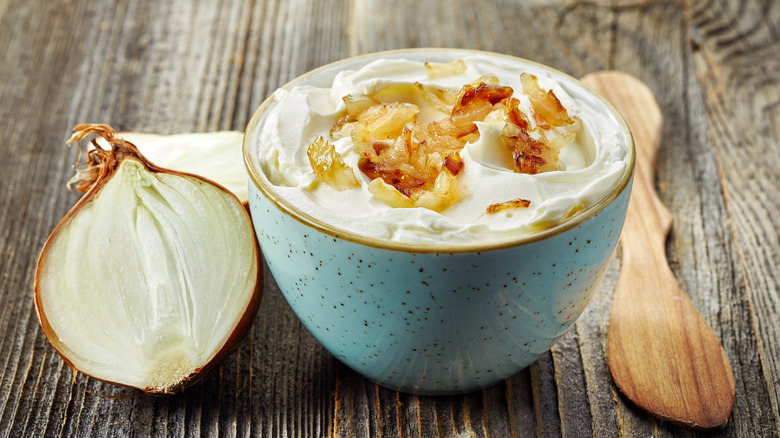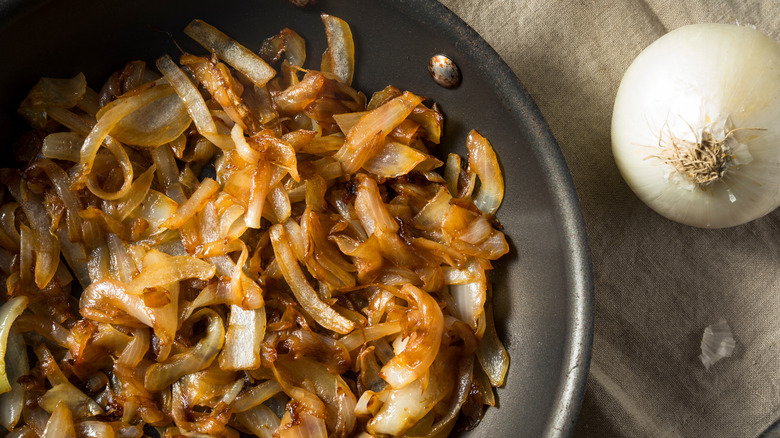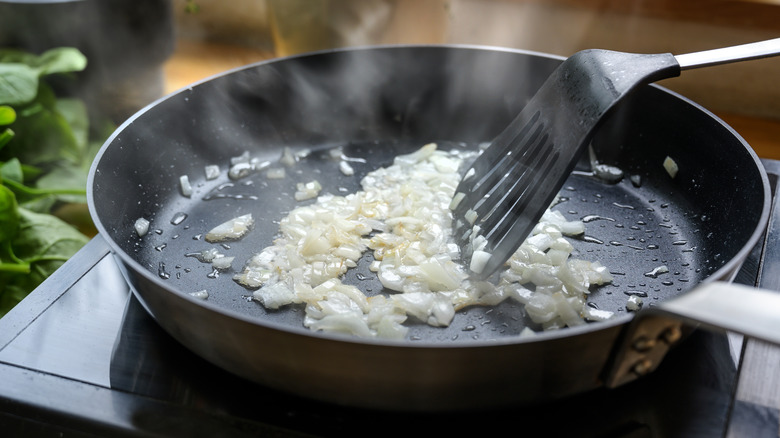Spruce Up Store-Bought French Onion Dip With Caramelized Onions
Chips and dip are a snack staple when hosting guests. When you need a little extra something on the table but don't want to cook another from-scratch appetizer recipe, more often than not, it's this combo to the rescue. And you can hardly go wrong with a French onion dip. While the store-bought version is a great start, you can take things up a notch by adding caramelized onions, which bring major allium flavor and a luscious texture to the dish.
Even though it's a slow and steady process, it's easy to make mistakes when caramelizing onions; it requires attention but minimal effort. While any type of onion can be caramelized, you should stick with either yellow or Spanish onions, which create a good balance between that pungent taste we know and that sweeter profile that comes out when they're cooked. You can use sweet onions, but they're naturally sweeter than other varieties, so caramelizing them might make them too sweet for some people. Red onions will work but will turn purplish and be slightly on the sharp, almost bitter side. You can heighten the flavor with various ingredients (like vinegar or herbs) during the cooking process. The more you enrich your onions, the better your doctored dip will be.
Get the most from your caramelized onions
Caramelizing onions is simple, but expect to dedicate at least 45 minutes to the process; it can take up to an hour. Slice your onions to be about ⅛-inch thick (make sure to slice them evenly, so they cook down at the same time).
One thing to keep in mind when caramelizing onions is surface area. You'll want to add them to a pan that's spacious enough for the onions to get hit with an even amount of heat. Use your best judgment here, depending on how many onions you're caramelizing. Just don't pile your onions into a too small of a pot or else they'll cook unevenly and slowly.
Hit the onions with either oil or butter; the fat will help them soften and start to cook down. They need frequent stirring to ensure they don't burn, and if there are stuck-on bits at the bottom of the pan, you can deglaze it by adding a little water. Or, for even more flavor, pour in a little bit of beef broth or white wine instead. You'll have to keep adding liquid judiciously as needed, keeping an eye on the onions and stirring them often until they're a rich, dark brown color.
If you plan to serve your onion dip cold, let the onions cool completely before adding them to the dip. Or, if you prefer a warm dip, you can add them as soon as they're done cooking.
The science behind caramelized onions
Onions have an almost mystical way of turning into something completely different when they're hit with low and slow heat. While onions cook, the sugars within them break down and build that sweeter flavor we know and love when exposed to heat. But something called the Maillard reaction also occurs here; it's when the heat hits both the amino acids and the sugars, which creates unique molecules that didn't previously exist. It's responsible for that deep golden or amber color, as well as the umami flavor that pairs perfectly with the onion's inherent sweetness — and it all undoubtedly makes store-bought onion dip that much better.
Knowing what goes into making this elevated snack, you may be tempted to hold onto it for as long as possible. While some store-bought onion dips can last up to two weeks once they're opened, caramelized onions — and in turns, caramelized onion dip — will only stay at its best quality for about a week. After that, take a look at the dip's texture and check for an off smell to determine whether it's still safe to eat.


